Enjoy a simple French Toast recipe ideal for brioche or challah bread. Combine milk, eggs, vanilla, and cinnamon, soak the bread, and fry until golden. Serves 4, perfect with berries, syrup, and whipped cream for a delightful breakfast.
French toast, a beloved breakfast classic, has a rich history that dates back to ancient times. Often associated with France, its origins are actually much older and not strictly French. Known as “PAIN PERDU” or lost bread in France, the dish was a clever way to use stale bread, soaking it in a mixture of milk and eggs before frying it to perfection. This resourceful recipe allowed nothing to go to waste, showcasing the ingenuity of cooks from centuries past.
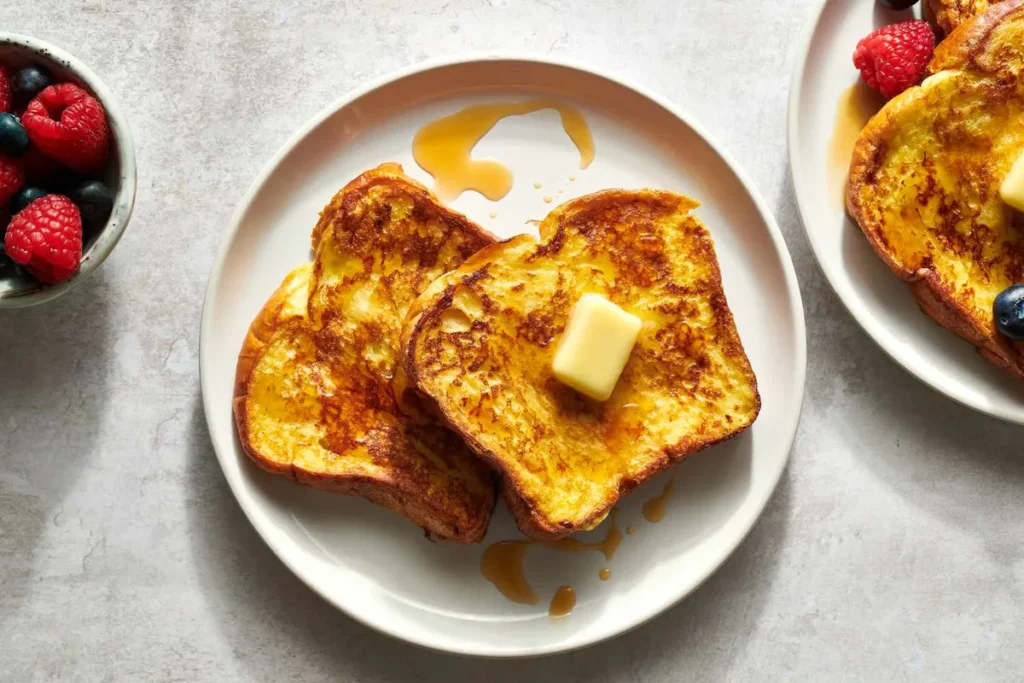
The beauty of French toast lies in its simplicity and the joy it brings to the breakfast table. Over the years, it has evolved, with each culture adding its own twist to the basic recipe. From the addition of sweet spices like cinnamon and nutmeg to the lavish toppings of fresh fruit, syrup, and whipped cream, French toast has become a canvas for culinary creativity. Despite its global variations, the essence of French toast remains the same: turning simple ingredients into a delightful meal that warms the heart and satisfies the soul.
Best French Toast Recipe
I tried many ways to make French toast and learned something important: simple is best. This recipe is my favorite because it’s easy and tastes amazing. It’s just right for lazy weekend mornings. Let this be your special recipe, showing that the easiest way is sometimes the tastiest.
What ingredients are in French Toast?
- Bread
- Milk
- Eggs
- Vanilla
- Sugar
- Cinnamon
What is The Best Bread for French Toast?
Picking the right bread for your French toast can really change the game. Here’s a little guide to help you find your perfect match, keeping things simple and sweet (or savory, if that’s your jam!).
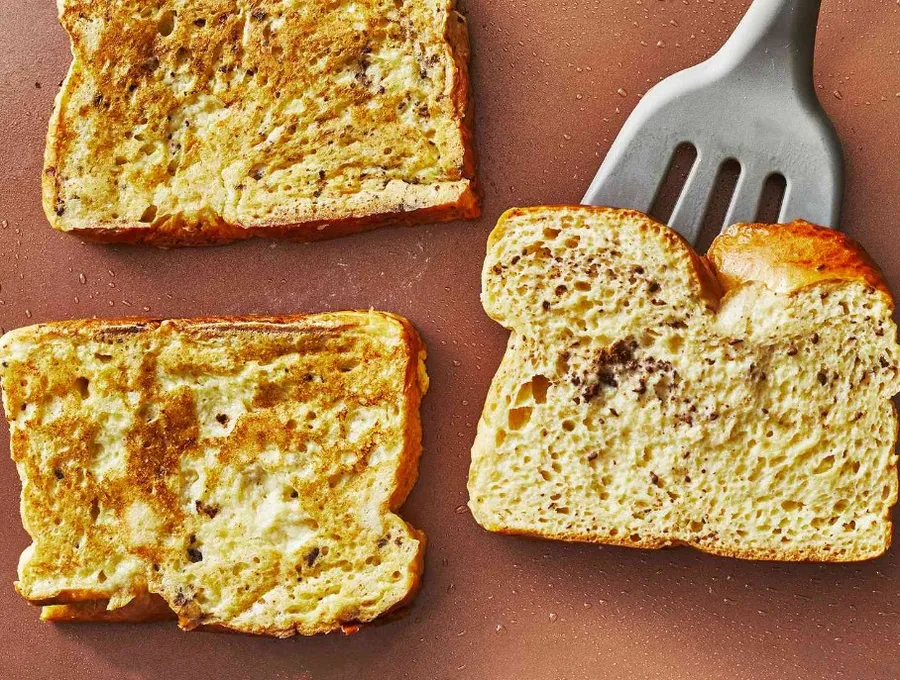
- Sturdy and Eggy: First things first, you want bread that can stand up to the egg mixture without turning into a soggy mess. Brioche, challah, and thick-cut Texas toast are awesome for this because they’re a bit eggy and buttery, making them strong enough to soak up all that goodness without falling apart.
- Slightly Stale: Now, if you’ve got fresh bread, it might be too soft right off the bat. But, no worries! Day-old bread is actually better for French toast because it soaks up the egg mix just right, giving you that perfect soft inside and crispy outside. If your bread is still fresh, a quick toast in the oven can dry it out a bit and get it ready for dipping.
- Flavorful: When it comes to taste, think about what you like. Brioche is super buttery and rich, which is amazing with sweet toppings. Challah has this nice, slightly sweet taste. And sourdough? It brings a little tang, which could be really cool with savory toppings.
Here’s a quick rundown of some popular choices:
- Brioche: It’s like the superstar of this recipe. Rich, buttery, and just decadent.
- Challah: Eggy and a bit sweet, making it another top pick.
- Thick-cut Texas toast: Easy to find and has a great structure for soaking up all that egg mixture.
- Sourdough: A bit sturdy and tangy, offering a nice twist for those who like a little zing.
The best part is trying out different types to see what you love the most. Whether it’s the creamy dreaminess of brioche or the unique kick of sourdough, there’s a bread out there that’ll make your French toast just how you like it. So, go ahead and experiment!
How to Make a French Toast
First up, grab a shallow dish and whisk together your eggs, milk, a splash of vanilla, a dash of cinnamon, and a pinch of salt. This mix is going to give your bread that lovely, custardy middle we all love in French toast.
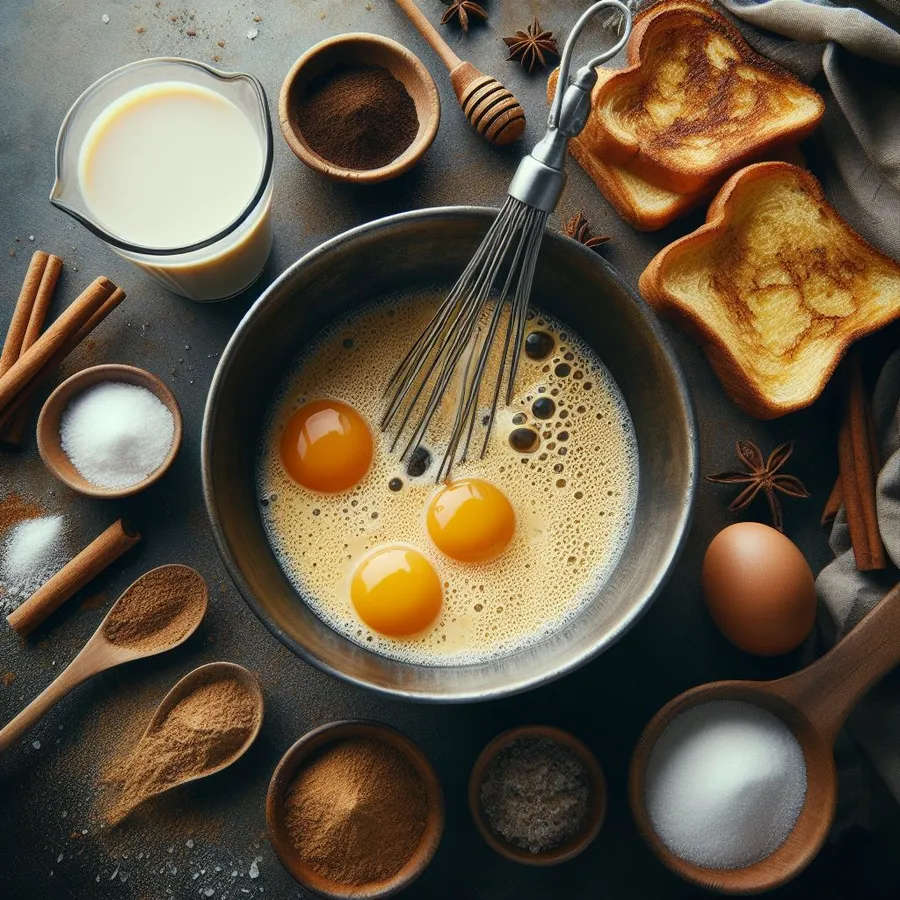
Now, take your bread—stale works best because it soaks up the egg mixture just right without getting too mushy. Dip each slice into the egg mixture for about 3 seconds on each side. You want to coat it well but not let it sit too long.
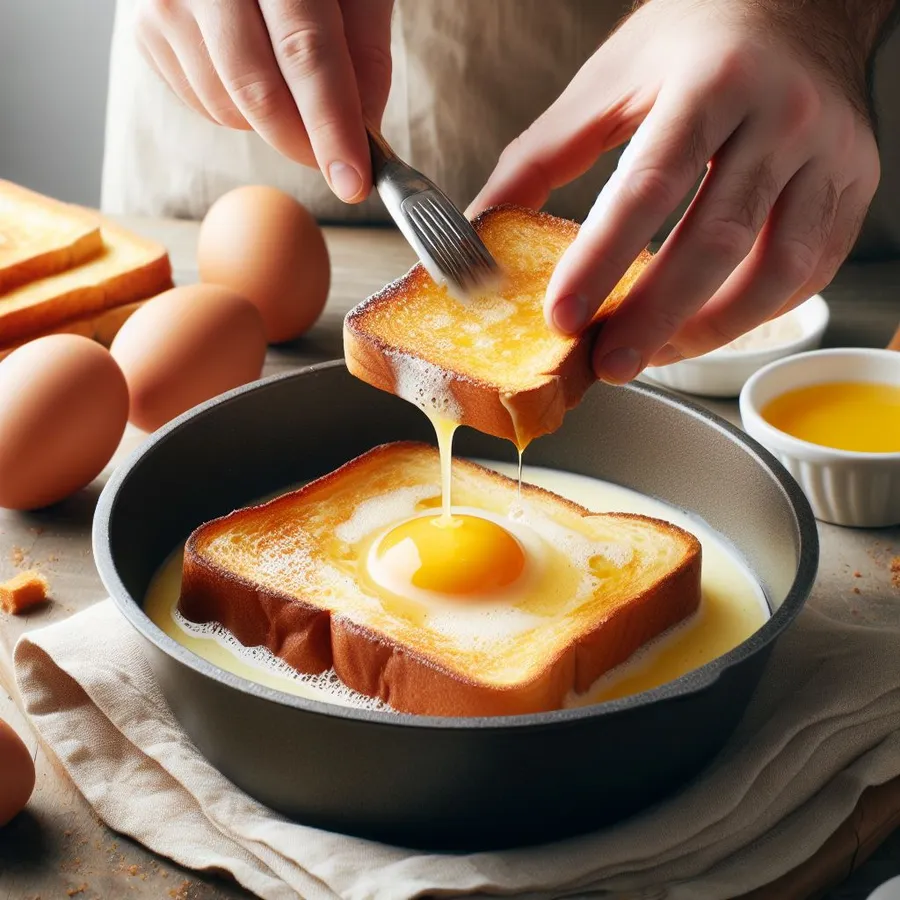
We’re aiming for that perfect balance where the outside crisps up nicely while the inside stays soft and custardy, not wet.
Heat a bit of butter in a pan over medium heat. Once it’s melted, add your soaked bread slices. Let them cook for about 3-4 minutes on each side until they’re beautifully golden brown. If you’re eating them straight away, pop them on a wire rack; this keeps them crispy.
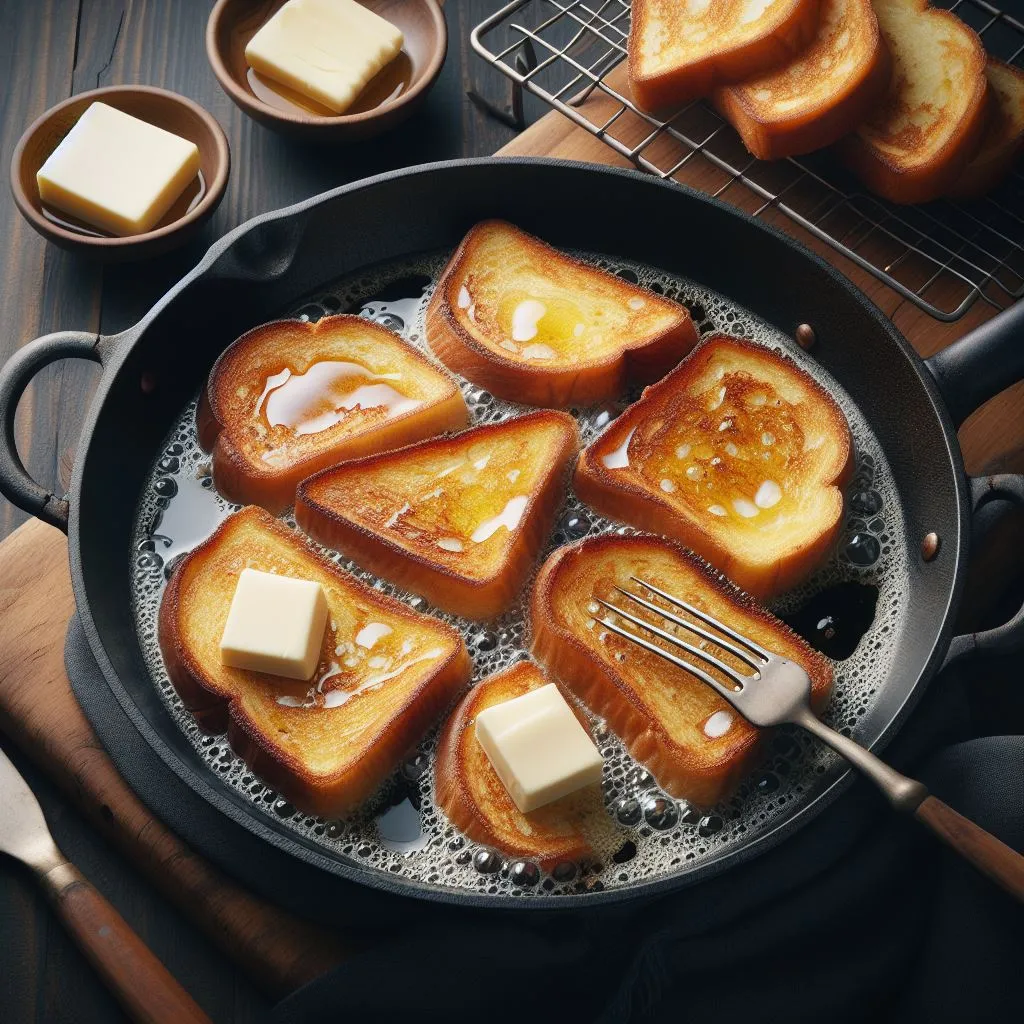
When making French toast for a bunch of people, it’s crucial to keep the first batches warm. An easy trick is to lay out the cooked slices on a baking sheet and pop them into an oven set at 250 degrees. This helps maintain their warmth without making them soggy.
Microwaving can be a quick fix, but it might make your French toast lose its crispiness. A better option for enjoying them later is to give them a quick toast in the toaster. This brings back the delightful crunch, making them taste freshly made, even if they’ve been sitting for a while.
This simple step ensures your French toast stays warm and crisp, ready to be enjoyed whenever you’re ready. It’s perfect for relaxed weekend brunches or when you have a hungry crowd to feed and want each slice to be just right.
Toppings For French Toast
- Butter
- Maple Syrup
- Fruit
- Whipped Cream – Whip Some Heavy Cream With Some Sugar For Fresh Whipped Cream.
- Powdered Sugar
- Raspberries
- Blueberries
- Strawberries
- Blackberries
- Peaches
- Sliced Almonds
Soggy French Toast
Soggy French toast is the enemy of a perfect breakfast! It occurs when the bread absorbs too much of the egg mixture, resulting in a mushy and disappointing center instead of a fluffy, light interior. But fear not, there are ways to prevent it and achieve that perfect balance of a fluffy interior and crispy exterior. Here’s what you can do:
Choosing the Right Bread:
- Stale is good: Fresh bread tends to be too soft and absorbs too much custard, leading to sogginess. Opt for day-old bread like brioche, challah, or even thick-cut Texas toast. These have a sturdier structure that holds up better.
- A quick dry: If you only have fresh bread, a quick fix is to dry it out slightly. Toast it on the lowest setting in your toaster for a minute or two, or place slices on a baking sheet in a preheated oven at 300°F (150°C) for a few minutes. Just be sure it doesn’t brown.
Cooking is Key:
- Medium heat is your friend: Don’t crank up the heat! Use medium-low heat to cook your French toast slowly. This allows the inside to cook through without burning the outside, which can lead to trapped moisture and sogginess.
- Don’t crowd the pan: Cooking too many slices at once can lower the pan’s temperature and lead to uneven cooking, potentially resulting in soggy French toast.
Bonus Tip:
- Melted butter: Use melted butter instead of oil to cook your French toast. Butter adds a richer flavor and helps achieve a nice golden brown color.
What type of bread is best for French toast?
The “best” bread depends on your preference, but some general tips:
- Sturdy and eggy: Brioche, challah, or thick-cut Texas toast are great choices due to their higher egg and butter content, holding their shape well.
- Slightly stale: Day-old bread absorbs the custard evenly without getting mushy. If using fresh bread, toast it briefly to dry it out a bit.
- Flavor profile: Consider your toppings. Brioche is rich and buttery, ideal for sweet toppings. Challah has a touch of sweetness, while sourdough offers a hint of tang for savory options.
How do I keep French toast warm for a crowd?
Here’s a simple trick to keep your French toast warm without getting soggy:
- Preheat your oven to 250°F (120°C).
- After cooking, arrange the French toast slices on a baking sheet in a single layer.
- Pop them in the oven to maintain warmth. This prevents sogginess from microwaving and revives crispness later.
What can I do to prevent soggy French toast?
Soggy French toast is a bummer! Here’s how to achieve a delightful balance:
- Bread choice: Opt for day-old bread like brioche or challah, which hold up better.
- Don’t over-soak: Briefly dip each slice in the egg mixture (10-15 seconds per side). Thicker custard might require even less soaking time.
- Cook with medium heat: Use medium-low heat to cook slowly. This allows even cooking without burning the outside, which can trap moisture and lead to sogginess.
- Don’t crowd the pan: Cooking too many slices at once lowers the pan’s temperature and promotes uneven cooking, potentially resulting in sogginess.
What are some topping ideas for French toast?
French toast is a canvas for creativity! Here are some classic and exciting options:
- Classic sweet: Maple syrup, powdered sugar, fresh berries, whipped cream.
- Fruity delights: Sliced bananas, peaches, mangoes, with a drizzle of honey or agave nectar.
- Nutty twist: Toasted almonds, pecans, walnuts, with a maple syrup and cinnamon combo.
- Savory surprise: Top with sautéed vegetables, cheese, and a drizzle of hot sauce.
Can I make French toast ahead of time?
Absolutely! Here’s how to prep French toast in advance:
- Prepare the French toast batter and soak the bread slices. Cover and refrigerate for up to 24 hours.
- When ready to cook, remove the soaked bread and let it sit at room temperature for 15-20 minutes. Cook as usual.
What are some vegan or vegetarian variations of French toast?
Here are some delicious plant-based options:
- Vegan French Toast: Use a flaxseed or chia seed egg substitute and vegan milk (almond, soy, oat) in the batter. Top with fresh fruit and vegan whipped cream.
- Vegetarian French Toast: Substitute regular eggs with a combination of mashed avocado and plant-based milk in the batter. Add crumbled cheese on top for a protein boost.
French toast
Ingredients
- 4 large eggs
- 2/3 cup milk
- 1/4 cup all-purpose flour
- 1/4 cup granulated sugar
- 1/4 teaspoon salt
- 1 teaspoon ground cinnamon
- 1 teaspoon vanilla extract
- 8 thick slices bread
Instructions
- In a bowl, whisk eggs, milk, cream, vanilla, and cinnamon.
- Dip brioche slices in the mixture for 2-3 minutes per side.
- Heat oil and butter in a pan until foaming.
- Cook soaked brioche until golden, 3 minutes each side.
- Keep cooked French toast warm in the oven.
- Serve with icing sugar and fresh berries.
Video – Make a delicious breakfast. French toast recipe!
Meet Evelyn, the culinary genius behind BlackPigCle's delectable recipes. With a passion for flavor and creativity, Evelyn crafts mouthwatering dishes that tantalize the taste buds and inspire food lovers everywhere. Dive into her recipes and elevate your culinary adventures with Blackpigcle.

